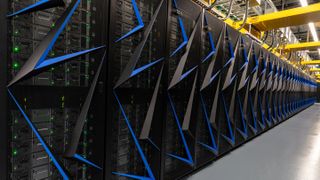Meet the researcher taking the fight to Covid-19, with the help of a world-beating supercomputer
‘Coronavirus research is moving at rocket speed, but it feels like wading through molasses,’ says Dan Jacobson

Like many of us, Dan Jacobson grew up playing with computers - but his machines were a little more sophisticated than you’re probably imagining.
Courtesy of his scientist father, Jacobson spent his formative years in close proximity with mainframes (hulking beasts designed for particularly compute-intensive tasks) and even, he says, types of calculator not available outside of laboratories at the time.
This unconventional childhood quite probably laid the foundation for the 30-year professional romance with high performance computing (HPC) that was to follow, during which period he has worked with some of the most powerful machines in existence.
- Here's our list of the best workstations on the market
- We've built a list of the best video editings PCs available
- Check out our list of the best business computers out there
Today, he is a Computational Systems Biologist at the Oak Ridge National Laboratory (ORNL) in the US, which happens to be the home of the IBM Summit supercomputer, previously the world’s fastest at over 200 petaFLOPS (by the HPL benchmark).
Jacobson and his 20-strong team - made up of experts in fields as diverse as biology, artificial intelligence, engineering, statistics and more - are harnessing IBM’s supercomputer to investigate the mysteries of the coronavirus.
The product of said experiment is a new theory about the nature of the virus which, if verified, could have significant implications for the way patients are treated.

Laying the foundations
Asked what a typical day in the life of a computational systems biologist looks like, Jacobson had no answer for us. In fact, he laughed.
Are you a pro? Subscribe to our newsletter
Sign up to the TechRadar Pro newsletter to get all the top news, opinion, features and guidance your business needs to succeed!
“I’m not sure there is a typical day-to-day. The job is a combination of brainstorming, meeting with collaborators, managing existing projects, reviewing literature, writing grants and manuscripts etc.,” he told us.
As varied as his work might be, though, a common thread has run throughout both Jacobson’s time at ORNL and his career as a whole - that of data integration.
He describes this practice as an “attempt to tie disparate types of data together to better understand a system as a whole”. It sounds simple enough, but the pursuit of said goal has carried him across sectors, disciplines and continents over the last three decades.
Predictably, he’s worked in lab settings and academic environments (including a stint at Johns Hopkins University), but has also dabbled in entrepreneurialism and even ran an NGO for a period.
In each of these roles, Jacobson found himself drawn to the intricate details that made up the whole; the micro events that contribute to a macro effect.
In the context of his coronavirus research, for example, his concern is with unpicking the fundamental biology and molecular evolution of the virus, with the ultimate goal of understanding how it manifests itself in the human body and, on occasion, kills its host.
The problem with intricate detail, however, is that there is invariably a lot of it. And to analyze detail, Jacobson needs a way to perform calculations as quickly as possible.
Need for speed
Enter supercomputers - the silent heroes of this narrative - which provide the means of doing just that: performing calculations and processing information magnitudes faster than would otherwise be possible.
Jacobson estimates his team has been allocated hundreds of thousands of node hours with Summit and was even using the machine before construction was complete. So, it’s safe to say he knows his way around a supercomputer.
Over the course of his career, he has applied supercomputing resources in a mind boggling range of contexts, from bioenergy and microbiology to biomedicine, neuroscience (in relation to the problems of suicide, autism and substance abuse) and more.

“What we find is that the tools and algorithms we develop for one system apply just fine to others. The algorithms don’t really care about what species we’re dealing with,” he explained.
“If you compare the work we do on plants and the work we do on humans, we actually learn a lot from one that can be applied to the other.”
A crucial element to work of this kind is optimizing the utility of algorithms by a process of streamlining. The less taxing an algorithm is to execute, the more calculations a supercomputer can perform per second.
For their work in this area, Jacobson’s team won the prestigious Gordon Bell prize in 2018, awarded for “innovation in the application of HPC to challenges in science, engineering and large-scale analytics”.
They had developed an algorithm to identify genes that may be more susceptible to opioid addiction, as well as potential treatments. Cast into a 16 bit matrix, this algorithm was capable of running at 2.35 exaFLOPS on IBM Summit, making it the first of its kind to breach the exascale barrier (equal to 1 billion calculations per second).
To reach these heights, the team had minimized the algorithm’s necessary numerical precision and tweaked it further to make specific use of the Tensor Cores inside Summit’s 27,648 Nvidia Volta GPUs.
However, while Jacobson’s work with supercomputers has always been of consequence, his wealth of experience has possibly never been channeled towards a more worthy subject than it is today: the highly infectious virus that has claimed the lives of more than a million to date.
Coronavirus and the bradykinin storm
Discussing his team’s coronavirus research, Jacobson couldn’t help but dive straight into the nitty gritty science. There was no room for the layman on this particular expedition, so TechRadar Pro just had to buckle up.
In terms as simple as possible, his team is proposing that Covid-19 is in fact a vascular illness (of the veins and arteries etc.) rather than just a specific respiratory problem (of the lungs).
It might sound cheesy, but the realization came to Jacobson in the form of a eureka moment on a Sunday afternoon - and it centred on a protein called bradykinin, responsible for the dilation of blood vessels.
When it infects a human host, coronavirus causes what Jacobson refers to as a “bradykinin storm”, meaning that activity relating to the protein is increased dramatically, far beyond regular levels.
This triggers a series of biological events (e.g. an increase in the permeability of blood vessels and the production of hyaluronic acid) that ultimately floods the lungs with a “gelatin-like substance”, making it harder for the sufferer to breathe.

“On the internal surface of your lungs, you have about 70 to 100 square metres of surface area, covered in capillaries. You can imagine that if you make those capillaries really permeable and fluid is pouring into your lungs, that’s not a good thing,” Jacobson explained.
An analysis of the downstream effects of a bradykinin storm in the body shows close correlation with other symptoms displayed by coronavirus patients - including a dry cough, loss of smell, sore muscles, confusion, diarrhea, nausea etc. - all of which would appear to corroborate the team’s findings.
The good news, according to Jacobson, is that there are “a dozen or more drugs known to hit different parts of this mechanism”. Ultimately, he told us, treating coronavirus sufferers effectively will be about addressing each of the various issues brought about by the bradykinin storm in turn.
“If you sail your boat over a reef and poke five holes in the bottom of your boat, one cork may not solve your problem. You’re going to want five corks,” he explained, perhaps sensing we weren’t quite following the science.
Jacobson is the first to admit that there is much more work to do, many more trials to be conducted and data still to be analyzed - but the theory, he says, is “much more than just a promising start”.
Moving through molasses
For all Jacobson’s enthusiasm for the potential significance of his team’s findings, a mighty roadblock still stands in his way: the scientific review process.
Asked how long he thought it might take for his discovery, if verified, to manifest in changes to the way patients are treated, an apologetic Jacobson just couldn’t say.
“How long is a piece of string?” he joked. “There’s a lot of collaboration, discussion and negotiation. There are many moving pieces, but we’re pushing hard to make that happen.”
He says the speed at which coronavirus-related studies are being conducted and reviewed is far more rapid than usual, for obvious reasons. But the waiting is no less excruciating.
“Everything is moving at rocket speed, by normal scientific timelines, but to us it feels like molasses. Going through the normal review process is super important, of course, but it’s so painful to wait.”
“But, that’s the nature of the beast,” he added, we imagine with a reluctant shrug of the shoulders.
- Here's our list of the best cloud computing services on the market

Joel Khalili is the News and Features Editor at TechRadar Pro, covering cybersecurity, data privacy, cloud, AI, blockchain, internet infrastructure, 5G, data storage and computing. He's responsible for curating our news content, as well as commissioning and producing features on the technologies that are transforming the way the world does business.
